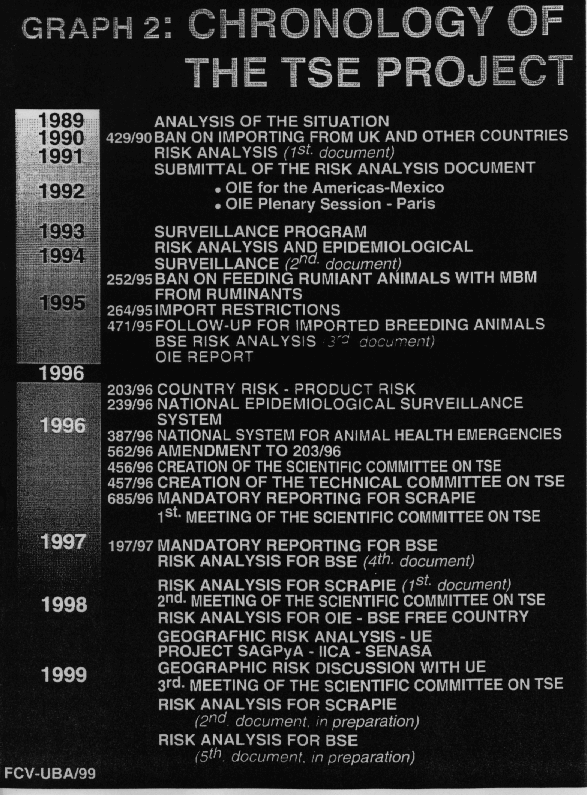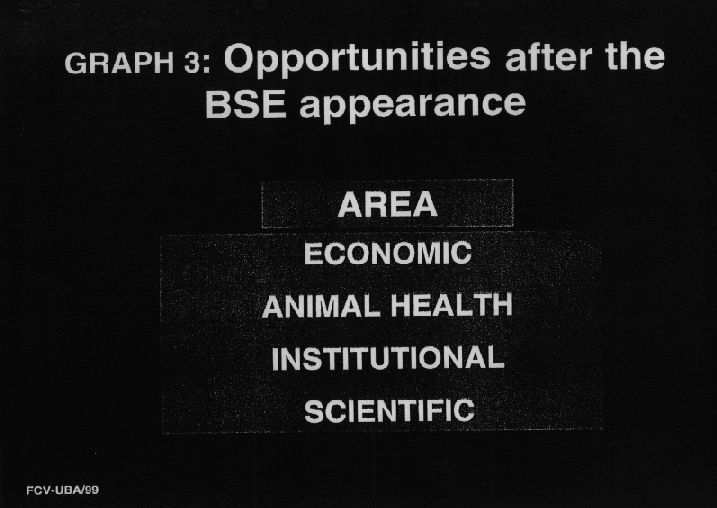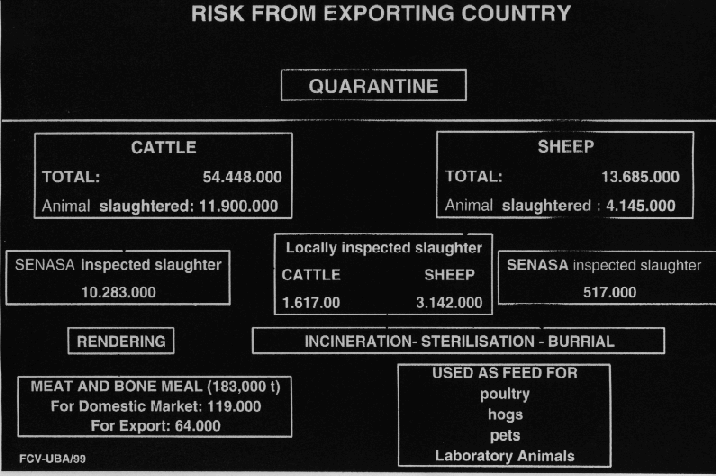
Prevention Program for Animal Transmissible Spongiform Encephalopathies in Argentina. Opportunities
Alejandro A. Schudel (1), Carlos van Gelderen (2), Luis O. Barcos (3)
Transmissible spongiform encephalopathies (TSEs), or prion diseases, are a group of neurodegenerative diseases that affect humans and animals. Scrapie, which has been known for over 200 years, is the characteristic disease of what are known as animal transmissible spongiform encephalopathies that naturally affect sheep, goats, minks, deer and cattle.
The first cases of a new disease in cattle, known as Bovine Spongiform Encephalopathy (BSE) were detected in the United Kingdom in 1986 (Wells, et al, 1987). The outbreak that followed gained very serious characteristics. To date, over 171,000 bovines on 34,746 farms in the UK have been affected (MAAF UK, July 1998). The outbreak extended to other countries (the Republic of Ireland, Switzerland, France, Portugal, The Netherlands, Belgium and Luxembourg) and affected native animals and others imported from the UK (Canada, Switzerland, Portugal, Germany, Oman and the Malvinas Islands).
The BSE outbreak in the UK led authorities to adopt stringent health actions to restrict the transmission of the disease and protect the health of the population. When the cause of the fatal cases in humans that were reported in March 1996 was identified as a variant of CJD (v-CJD) that was related to BSE, the UK implemented very severe control measures. Other countries put in place strict prevention mechanisms. Later, investigations by Collinge et al (1996) on the molecular characterization of strains of CJD, and experimental studies on transmission to conventional and transgenic mice, by Bruce et al (1997) and Hill et al (1997) confirmed the close relationship between the prions causing BSE and v-CJD.
The long incubation period, the absence of diagnostic methods, the lack of information on the type of agent and its transmission pattern, have led to the adoption of preventive measures to avoid the spreading of the disease. Argentina followed closely the developments of the outbreak in the UK.
To protect its sanitary status, in 1989 Argentina put in place a specific Prevention Plan for animal TSEs. The Plan was based on the regulatory and operational recommendations issued by international organisations.
As a result of the Technical Cooperation agreement signed in 1989 between the Research Institute and a pharmaceutical company, Argentina began an assessment of its health status for this new disease which, until then, was unknown in the country. The results of the first stage of the assessment, which included a sanitary and production profile of the Argentine livestock industry, indicated that Argentina was free of BSE. In spite of this, and given the importance of meat production both for the domestic market and for export, farmers were informed, preventive actions were taken, and a detailed study to identify the sources of risk was developed.
In 1989, the Secretariat of Agriculture, Livestock, Fisheries and Food (SAGPyA) took immediate action and issued the first rules on Prevention of TSEs in Argentina. The Secretariat then formed a working group of specialists from the public and private sectors and entrusted them to carry out the first studies on BSE Risk Factors in Argentina. The results of the studies, that were based on the epidemiological assessment for BSE performed by the UK, were published in 1991 (Cane et al). They showed that the main factors for the occurrence of BSE were:
- A large sheep population in which Scrapie was endemic.
- The use of rendering process material as an input to manufacture MBM.
- The use of a rendering process that did not inactivate the TSE agent.
- Feeding ruminant animals with MBM from ruminants.
The research carried out by Argentina indicated that, as a result of the non-existence of the risk factors identified in the UK and the absence of cases of the disease, Argentina could be considered a BSE free country. (Graph 1).
To strengthen the sanitary situation, and in full compliance with the international standards set forth in the International Animal Health Code of the OIE, Argentina included specific surveillance for BSE in its Prevention Plan in 1993. The results were published in the second Risk Analysis Report (Schudel et al, 1994), and served as documentation and technical basis for all the actions that have been developed to date.
Additional preventive measures which included a ban on feeding ruminant animals with MBM from ruminants, restrictions on imports, and a follow-up of all imported breeding animals, were adopted in 1995. The update of the BSE Risk Analysis, which was published in 1996 (Schudel et al 1996), confirmed Argentina's status as a BSE free country, and included strong technical, regulatory and documented data.
In March 1996, the confirmation of a causal relationship between the BSE outbreak in the UK and the appearance of cases of a new form of Creutzfeldt- Jacob Disease - known as v-CJD - caused an international crisis that seriously affected the beef trade. In spite of this, as operational and regulatory actions had already been taken with the TSE Prevention Plan implemented by SAGPyA, Argentina was able to strengthen its position and make important adjustments to the Plan. One of the most important ones was the creation, at the highest level of authority, of two permanent Committees, a Technical Advisory Committee and a Scientific Advisory Committee of international and local experts in animal and human TSEs. The Committees have met regularly once a year to assess the global situation and specifically Argentina's, to ensure that Argentina is BSE free (Table 1). Additional lines of action for other animal TSEs were adopted as a result of these meetings. These actions included risk analysis, surveillance for scrapie, an animal feed surveillance system, and collaborative work with the Reference Laboratory for human TSEs. Graph 2 clearly shows the chronological order of the actions taken and the increasingly demanding requirements of the Prevention Plan.
Over 4,800 brains from cattle, sheep, goats, camelidae and deer were tested with state-of-the-art technology for the Prevention and Surveillance Plan. To date, all test results have been negative. In addition, a comprehensive informative program has been deployed both within the country and abroad. A Surveillance Program for compound feed manufacturing plants was put in place in 1997 to identify potential internal risks. The data from this Program will also serve to annually update the risk analysis for BSE and Scrapie (1998, 1999).
The complete document required by the E.U. on the Geographic Risk Assessment for BSE in Argentina has been submitted. The document, which includes all the information collected by the TSE Prevention Plan, was highly praised by the international experts who analysed it. (Barcos L. et al 1998).
The preventive actions, which have been continuously updated, as recommended by the international bodies in this field (OIE- International Animal Health Code - BSE, Chapter 3.2.13), have enabled the country to satisfy all the requirements to qualify as an animal TSE free country. The importation of infected animals is the single source of potential risk for the entry of these diseases.
The Prevention Plan that SAGPyA implemented, enabled Argentina to gain the recognition as an animal TSE free country and to identify economic, sanitary, institutional and scientific opportunities. (Graph 3). The economic and commercial benefits are clearly that Argentina can access new markets. From the animal health point of view, the creation of a team of national and international experts who have clearly defined roles and work within the sphere of their institutional responsibilities, enabled the formulation - within a short period of time - of a highly effective and efficient Plan which is probably unique in the field of Animal Health in Argentina. As the countries in the region have similar production economies and health systems, this model could be easily applied and provide immediate results. This would allow the consolidation of a regional status that would facilitate trade within the area and the formation of a common trade block for animal products and by-products (FMD and BSE free).
From the institutional point of view, the appearance of BSE has brought about profound changes in the role, structure and functioning of Animal Health Services which must now regain the consumers' confidence. Speaking about what is being done is no longer sufficient, actions must now be "documented".
It is for this reason that scientific and technical data will be increasingly necessary to provide prompt and reliable information. Animal Health Services, as guarantors of healthy products, will have to guarantee the quality and transparency of the information they provide.
The lesson for Argentina from the BSE outbreak in Europe is that change is possible, and that it is a good opportunity.




Bibliography